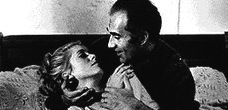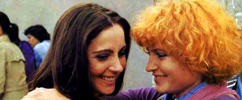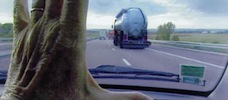Reviews
Les plages d’Agnès
Agnès Varda
France, 2008
Credits
Review by Ben Ewing
Posted on 11 August 2010
Source MUBI.com
Categories Viva Varda: The Films of Agnès Varda
Agnès Varda’s most recent film and the likely capstone of her long career, The Beaches of Agnès is a cinematic collage — a personal and professional autobiography that mixes remembrances with in-jokes and irreverent visual puns on the nature of artistic representation. Through narration, photographs, film clips and self-conscious reconstructions, Varda whimsically recounts her many lives: as a young photographer, a director, the wife of Jacques Demy, and, now, a charming octogenarian who continues to reflect and create. Amid serious histories she intersperses silly diversions. She drives a cardboard cutout car. She sits secluded in a large arts and crafts whale on the beach or a hut built of filmstrips. She talks to an animated orange cat that stands in for her friend Chris Marker, the notoriously elusive avant-garde filmmaker.
Varda has the right temperament for self-reflection — the perfect attitude for making a film about the process of, and her role in, cinematic construction. She exudes such a sense of controlled play and wonderment that, under her auspices, The Beaches of Agnès becomes not a didactic video lesson in postmodern problematics but a visual delight that seems to smuggle theory in under our noses. Rather than a hall of mirrors we are treated to a beach of them. “Do we relive the moment?” she asks. “For me, it’s cinema. It’s a game,” she answers. This is no pessimistic lament about the reductionist violence that representation does to its would-be objects. It’s a game, but what a game. It’s a life.
In The Beaches of Agnès, Varda always seems far more interested in the sensory joys and heart-rending nostalgia of photos and film than in polemics or intellectualization. This is appropriate. Though the godmother of the New Wave has stepped into both frontier experimentalism and steadfast feminist politics, she has generally come off as an accidental pioneer, more a vessel open to channeling serendipities than an executor of aesthetic or ideological agendas. Unlike the figures most immediately associated with the French New Wave — Godard, Truffaut, Rohmer, Chabrol, Rivette — Varda was neither a cinéphile nor a critic before becoming a director. Rather, as she explains in The Beaches and elsewhere, she was a young photographer who’d seen perhaps only ten or twenty films when, with the good fortune of help from Alain Resnais, she strung together her first film La Pointe Courte, one of the New Wave’s important precursors.
The Beaches of Agnès is, among other things, a guided tour of Varda’s filmography. In keeping with the image of her as an inadvertent innovator, Varda has created a body of films marked by a sense of experimentation neither aimless nor rigidly targeted. In her best works she has managed to create experiments in style that foreground the processes of representation without falling into the formalist trap of making them the exclusive center of attention. In La Pointe Courte, Varda played with forced juxtaposition — pitting a documentary-like depiction of a seaside town against a highly impressionistic story of young lovers’ strife — but made sure each half of the film attention was worthy in its own right. In Cléo from 5 to 7, she carried out an early exercise in “real time” cinema that, as she explains in The Beaches, attempted to combine the objective time of the film’s clocks and captions with the subjective time experienced by Cléo, a young singer afraid she has cancer. In Le Bonheur, Varda created a mood of nearly haunting yet still ambiguous irony through the use of over-the-top pastels, cheery Mozart, and near pathological “happiness.”
In The Beaches of Agnès, Varda’s image and tone encapsulate the ethos that has pervaded her oeuvre. Playful but wistful, aware of her significance to French film but shy about her accomplishments, Varda even carries the sense of incidental stature in her iconic mop of hair, her slow but the stately speech and bodily movements that occasionally give way to near baby-talk and semi-ironic sway-dancing. She speaks carefully, with dignified wispy emphasis, but as often in jest or self-deprecation as in solemnity.
Yet for all her apparent warmth and candor, there remains an elusive quality to Varda’s persona that keeps the viewer guessing and wanting more. The treatment of her relationship with and memories of Demy, for instance, hints at the depth of personal turmoil beneath the nostalgic gloss of The Beaches of Agnès. Though Varda reminisces lovingly about Demy and recounts the time leading up to his death in 1990 of AIDS, she offers only faint suggestions of the undoubtedly complex nature of their relationship. In his review of Le Bonheur, Ian Johnston questions whether that film’s indecisive treatment of a husband not “cheating” but rather, sharing “happiness” with another woman, might reflect “Varda’s own accommodations to her husband’s bisexuality.” One similarly wonders what it means when, in The Beaches, Varda cuts directly from clips of Le Bonheur to photos of her with Demy and their children.
Varda isn’t telling. Like the rest of her films and others’, The Beaches of Agnès only appears to relive moments that unfolded outside the frame. Fortunately, the lives and worlds inside her cinema — perhaps none more so than her own, in the reels that sum up her life in film so well — are large enough to stand alone.
More Viva Varda: The Films of Agnès Varda
-

Cléo from 5 to 7
1962 -

Le Bonheur
1964 -

Les Créatures
1966 -

Uncle Yanco
1967 -

Black Panthers
1968 -

Lions Love
1969 -

One Sings, the Other Doesn’t
1977 -

Daguerréotypes
1976 -

Mur murs
1981 -

Vagabond
1985 -

Jacquot de Nantes
1991 -

One Hundred and One Nights of Simon Cinéma
1995 -

The Gleaners and I
2000 -

Cinévardaphoto
2004 -

The Beaches of Agnès
2008
We don’t do comments anymore, but you may contact us here or find us on Twitter or Facebook.



